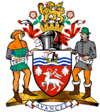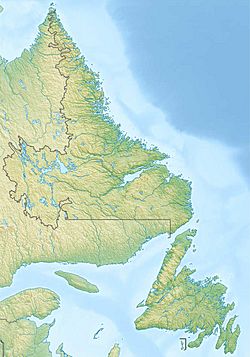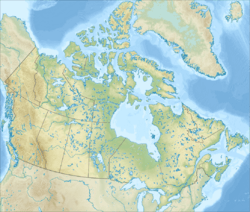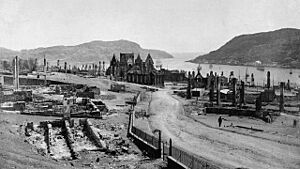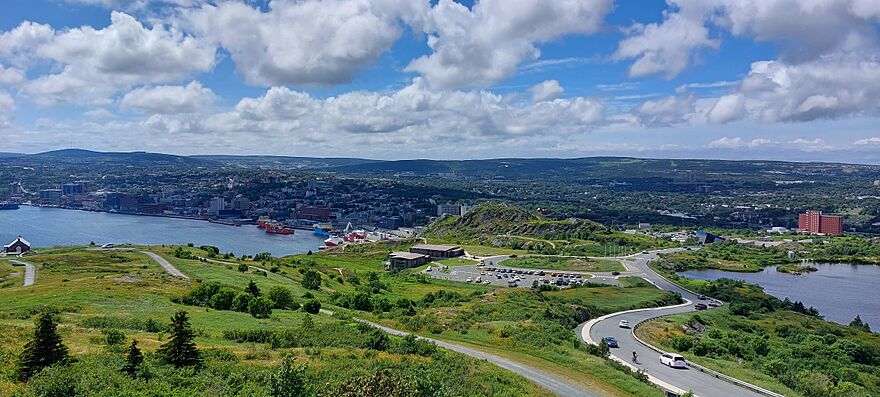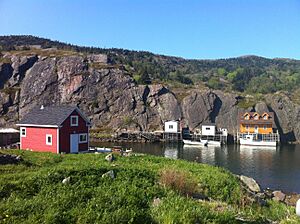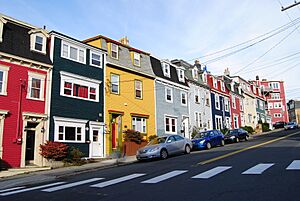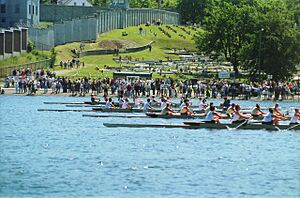St. John's, Newfoundland and Labrador facts for kids
Quick facts for kids
St. John's
|
|||||
|---|---|---|---|---|---|
|
City
|
|||||
| City of St. John's | |||||
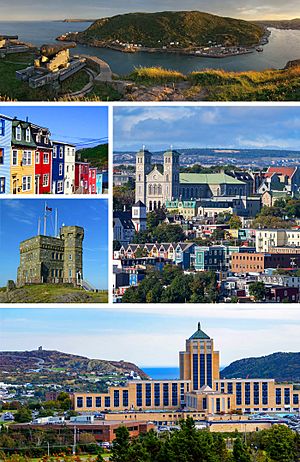
From top, left to right: Sunset from Signal Hill, Row Houses, Cabot Tower on Signal Hill, the Basilica of St. John the Baptist, the Confederation Building
|
|||||
|
|||||
| Motto(s):
Avancez (English: "Go forward")
|
|||||
| Country | Canada | ||||
| Province | Newfoundland and Labrador | ||||
| Census division | 1 | ||||
| Historic countries | Kingdom of England Kingdom of Great Britain United Kingdom of Great Britain and Ireland Dominion of Newfoundland |
||||
| Discovered | 24 June 1497 (Not as an established settlement, but as fishing grounds) | ||||
| Established | 5 August 1583 by Royal Charter of Queen Elizabeth I | ||||
| Incorporated | 1 May 1888 | ||||
| Named for | Nativity of John the Baptist | ||||
| Government | |||||
| • Type | City Council | ||||
| Area
(2021)
|
|||||
| • City | 446.02 km2 (172.21 sq mi) | ||||
| • Urban | 178.0 km2 (68.7 sq mi) | ||||
| • Metro | 931.56 km2 (359.68 sq mi) | ||||
| Elevation | 0–192 m (0–630 ft) | ||||
| Population
(2021 census)
|
|||||
| • City | 110,525 | ||||
| • Density | 247.8/km2 (632.1/sq mi) | ||||
| • Urban | 185,565 | ||||
| • Urban density | 1,042.5/km2 (2,700/sq mi) | ||||
| • Metro | 212,579 | ||||
| • Metro density | 228.2/km2 (591/sq mi) | ||||
| 20th Largest metropolitan area in Canada | |||||
| Time zone | UTC−03:30 (NST) | ||||
| • Summer (DST) | UTC−02:30 (NDT) | ||||
| Postal code |
A1A–A1H, A1S
|
||||
| Area code(s) | 709 | ||||
| NTS Map | Lua error in Module:Canada_NTS at line 17: attempt to index field 'wikibase' (a nil value). | ||||
| GNBC Code | ABEFS | ||||
| Total Dwellings | 54,067 (2021) | ||||
| Median total household income | $75,000 CAD (2020) | ||||
| GDP (St. John's CMA) | CA$13.2 billion (2016) | ||||
| GDP per capita (St. John's CMA) | CA$63,965 (2016) | ||||
St. John's is the capital and largest city in the Canadian province of Newfoundland and Labrador. It's located on the eastern tip of the Avalon Peninsula on the island of Newfoundland. The city covers about 446 square kilometers. It is the easternmost city in North America, not counting Greenland. The closest European place is Fajã Grande, in the Azores, Portugal, about 2,000 kilometers away.
The city's name might come from the belief that John Cabot sailed into the harbour on the feast day of John the Baptist in 1497. However, this is likely a legend that grew with British settlement. A more realistic idea is that a fishing village with the same name existed for much of the 1500s. It appeared as São João on a Portuguese map from 1519. This makes it one of the oldest cities in North America. St. John's officially became a city in 1888. Today, the St. John's Metropolitan Area has about 212,579 people. It is Canada's 20th-largest metropolitan area. It is also the second-largest in Atlantic Canada, after Halifax.
St. John's has a long and interesting history. It played a part in the Seven Years' War, the American Revolutionary War, and the War of 1812. The famous Italian inventor Guglielmo Marconi received the first wireless signal across the Atlantic Ocean in St. John's. Its history and culture make it a popular place for tourists to visit.
Contents
- Exploring St. John's History
- St. John's Geography and Climate
- Cityscape and Architecture
- Population and People
- St. John's Economy
- Culture and Fun in St. John's
- Sports and Recreation
- City Services and Transport
- Learning and Education
- Local News and Media
- Famous People from St. John's
- Sister Cities
- See also
Exploring St. John's History
Early Days: Fishing and First Claims (1500s-1700s)
St. John's was first used by fishermen who set up temporary camps in the early 1500s. Some believe that Sebastian Cabot and his father, John Cabot, were the first Europeans to sail into the harbour on June 24, 1497. This day is the feast day of Saint John the Baptist, which might be how the city got its name. However, where Cabot actually landed is still debated.
Portuguese explorers from the Azores also visited St. John's in the early 1500s. By 1540, ships from France, Spain, and Portugal crossed the Atlantic every year to fish near the Avalon Peninsula. Some people from the Basque Country believe their fishermen named St. John's. They thought the bay looked a lot like the Bay of Pasaia in their homeland.
The name São João first appeared on a Portuguese map in 1519. In 1527, an English sailor named John Rut visited St. John's. He found ships from Normandy, Brittany, and Portugal in the harbour. On August 5, 1583, Sir Humphrey Gilbert claimed the area for England. This was England's first overseas colony. But there were no permanent residents, and Gilbert was lost at sea soon after.
England re-established its claim in 1585 with Bernard Drake's Newfoundland Expedition. St. John's became a key base for his ships. This expedition greatly reduced Spanish and Portuguese fishing in the area. This helped England and France become more powerful in the region.
By 1620, fishermen from England's West Country controlled most of Newfoundland's east coast. St. John's became a permanent community sometime after 1630. Before this, the English government did not allow permanent settlements.
The town grew slowly in the 1600s. St. John's was the largest settlement in Newfoundland by 1675. Its population grew in the summers when many fishermen arrived. In 1680, fishing ships from South Devon brought many Irish men to work in the fishing industry.
The town built its first defenses after the Dutch admiral Michiel de Ruyter briefly took St. John's in 1665. The people fought off another Dutch attack in 1673. The English government planned to build stronger forts, but the French admiral Pierre Le Moyne d'Iberville captured and destroyed the town in 1696. When English soldiers arrived in 1697, they found the town in ruins.
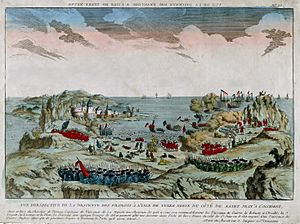
The French attacked St. John's again in 1705 and captured it in 1708. Each time, they burned many buildings. The harbour stayed fortified for most of the 1700s and 1800s. The last battle of the Seven Years' War in North America happened in St. John's in 1762. The French had captured the town, but British forces under Colonel William Amherst took it back at the Battle of Signal Hill.
Modern Times and Growth (1800s-Today)
The 18th century brought big changes to Newfoundland. The population grew, and a government and churches were established. St. John's became a garrison town, a government center, and a business hub. It was also a naval base during the American Revolutionary War and the War of 1812.
On December 12, 1901, Guglielmo Marconi received the first wireless signal across the Atlantic Ocean in St. John's. This signal came from his station in Cornwall, England. St. John's was also the starting point for the first non-stop flight across the Atlantic. This happened in June 1919, when Alcock and Brown flew a modified bomber from Lester's Field in St. John's to Ireland. In 2005, adventurer Steve Fossett repeated this flight in a replica plane.
During the Battle of the Atlantic in World War II, the harbour helped Royal Navy and Royal Canadian Navy ships fight submarines. The American Army Air Force also had a base there, Fort Pepperrell. This base was part of an agreement between the UK and the US. The base was later given to Canada in 1960 and is now called CFS St. John's.
In the 1990s, St. John's and the whole province faced hard times. The northern cod fishery collapsed, which had been the main part of the economy for hundreds of years. This led to high unemployment. However, the city's location near the Hibernia, Terra Nova, and White Rose oil fields brought a new economic boom. This led to more people moving to the city and new businesses. Now, the St. John's area creates about half of the province's economic output.
As of 2012, St. John's has 21 National Historic Sites of Canada. These are important places that tell Canada's story.
Fires That Shaped the City
St. John's has been hit by major fires many times. Big fires destroyed large parts of the city in 1816, 1817, 1819, 1846, and 1892. The most famous one was the Great Fire of 1892.
On February 12, 1816, a fire started in a house and quickly spread. It burned 120 houses, leaving about a thousand people without homes. There were two more city-wide fires in 1817, known as 'The Great Fire of 1817'. In 1819, another fire destroyed 120 houses.
A big fire in 1846 started when a glue pot boiled over in a shop. The fire spread quickly, helped by large amounts of seal oil stored in nearby businesses. The Great Fire of 1892 began on July 8, 1892. It spread due to several unfortunate events and burned almost all of the east end of the city, including many businesses.
St. John's Geography and Climate
Where is St. John's Located?
St. John's is on the coast of the Atlantic Ocean. It is on the northeast side of the Avalon Peninsula in southeastern Newfoundland. The city is North America's most easterly city, not including Greenland. It is about 475 kilometers closer to London, England, than to Edmonton, Alberta. It is also closer to all of Ireland than to Miami. St. John's is the largest city in its province. It is the second largest in the Atlantic Provinces, after Halifax, Nova Scotia.
The downtown area is west and north of St. John's Harbour. The rest of the city spreads out from downtown in all directions. The city covers a total of 446 square kilometers. Much of this area is still covered by undeveloped woods.
Plants and Trees in the City
The main trees in St. John's are black spruce, white spruce, and balsam fir. The largest tree that loses its leaves is the white birch. Other smaller trees include alder, cherry, and mountain ash. Many trees from other places also grow here. The sycamore maple is very common, and the Norway maple is also seen a lot. Other non-native trees include blue spruce, common horsechestnut, European beech, and littleleaf linden.
Understanding St. John's Climate
St. John's has a humid continental climate. This means it has four distinct seasons. The temperatures don't change as much as they normally would for its location. This is because of the warming effect of the Gulf Stream.
Average temperatures range from -4.9°C in February to 16.1°C in August. The city is also one of the places in Canada most affected by tropical storms. This is because it is on the Atlantic Ocean, where these storms travel from the United States. St. John's is one of the rainiest cities in Canada, outside of coastal British Columbia. This is due to tropical storms and moist air from the Atlantic Ocean.
Among major Canadian cities, St. John's is the foggiest, with 124 foggy days a year. It is also the windiest, with an average wind speed of 24.3 km/h. Rain and snow fall often and can be heavy. Summer is usually the driest season. The wettest months are from October to January, with December being the wettest.
In winter, different types of precipitation can fall from one storm. This includes rain, freezing rain, sleet, and snow. Snowfall is heavy, averaging about 335 cm each winter. However, heavy snow can turn into heavy rain, melting the snow. This means the snow cover can vary a lot. St. John's also gets freezing rain events, sometimes called "silver thaws". Major ice storms hit the city in April 1984 and April 2017.
On January 17, 2020, St. John's declared a state of emergency because of a huge snowstorm. It brought about 76 cm of snow, a one-day record, and winds up to 130 km/h. The Canadian Army was called in to help clear the snow. The state of emergency lasted eight days.
The highest temperature ever recorded in St. John's was 33.9°C on August 14, 1876. The coldest temperature ever recorded was -29.4°C on February 16, 1875.
| Climate data for St. John's (St. John's International Airport) WMO ID: 71801; coordinates 47°37′20″N 52°44′34″W / 47.62222°N 52.74278°W; elevation: 140.5 m (461 ft); 1991–2020 normals, extremes 1874–present |
|||||||||||||
|---|---|---|---|---|---|---|---|---|---|---|---|---|---|
| Month | Jan | Feb | Mar | Apr | May | Jun | Jul | Aug | Sep | Oct | Nov | Dec | Year |
| Record high humidex | 19.2 | 17.3 | 17.2 | 26.1 | 30.3 | 34.8 | 38.7 | 37.7 | 35.8 | 30.4 | 24.1 | 22.0 | 38.7 |
| Record high °C (°F) | 15.7 (60.3) |
16.0 (60.8) |
19.4 (66.9) |
24.1 (75.4) |
27.6 (81.7) |
30.6 (87.1) |
32.2 (90.0) |
33.9 (93.0) |
29.5 (85.1) |
24.6 (76.3) |
19.4 (66.9) |
17.9 (64.2) |
33.9 (93.0) |
| Mean daily maximum °C (°F) | −0.7 (30.7) |
−1.0 (30.2) |
1.2 (34.2) |
5.6 (42.1) |
11.0 (51.8) |
15.7 (60.3) |
20.9 (69.6) |
20.8 (69.4) |
17.0 (62.6) |
11.2 (52.2) |
6.7 (44.1) |
2.1 (35.8) |
9.2 (48.6) |
| Daily mean °C (°F) | −4.2 (24.4) |
−4.7 (23.5) |
−2.2 (28.0) |
1.8 (35.2) |
6.3 (43.3) |
10.8 (51.4) |
16.0 (60.8) |
16.5 (61.7) |
12.8 (55.0) |
7.8 (46.0) |
3.4 (38.1) |
−1.0 (30.2) |
5.3 (41.5) |
| Mean daily minimum °C (°F) | −7.8 (18.0) |
−8.4 (16.9) |
−5.7 (21.7) |
−1.9 (28.6) |
1.6 (34.9) |
5.9 (42.6) |
11.2 (52.2) |
12.1 (53.8) |
8.5 (47.3) |
4.3 (39.7) |
0.0 (32.0) |
−4.1 (24.6) |
1.3 (34.4) |
| Record low °C (°F) | −28.3 (−18.9) |
−29.4 (−20.9) |
−25.6 (−14.1) |
−18.3 (−0.9) |
−6.7 (19.9) |
−3.3 (26.1) |
−1.1 (30.0) |
0.5 (32.9) |
−1.7 (28.9) |
−5.6 (21.9) |
−14.4 (6.1) |
−20.0 (−4.0) |
−29.4 (−20.9) |
| Record low wind chill | −35.7 | −40.3 | −40.3 | −21.4 | −14.2 | −8.4 | −3.4 | 0.0 | −4.4 | −11.8 | −24.6 | −34.3 | −40.3 |
| Average precipitation mm (inches) | 153.0 (6.02) |
122.8 (4.83) |
140.1 (5.52) |
121.6 (4.79) |
98.1 (3.86) |
88.2 (3.47) |
100.1 (3.94) |
99.8 (3.93) |
125.8 (4.95) |
158.1 (6.22) |
157.4 (6.20) |
173.9 (6.85) |
1,538.9 (60.58) |
| Average rainfall mm (inches) | 67.7 (2.67) |
55.3 (2.18) |
78.9 (3.11) |
91.9 (3.62) |
93.6 (3.69) |
88.1 (3.47) |
100.1 (3.94) |
99.8 (3.93) |
125.8 (4.95) |
155.7 (6.13) |
132.4 (5.21) |
107.7 (4.24) |
1,197 (47.13) |
| Average snowfall cm (inches) | 95.4 (37.6) |
77.1 (30.4) |
62.0 (24.4) |
29.5 (11.6) |
4.5 (1.8) |
0.0 (0.0) |
0.0 (0.0) |
0.0 (0.0) |
0.0 (0.0) |
2.3 (0.9) |
22.3 (8.8) |
70.3 (27.7) |
363.4 (143.2) |
| Average precipitation days (≥ 0.2 mm) | 21.7 | 18.8 | 19.0 | 17.2 | 16.9 | 14.6 | 13.5 | 14.1 | 15.3 | 18.1 | 19.0 | 21.5 | 209.7 |
| Average rainy days (≥ 0.2 mm) | 9.7 | 8.4 | 10.9 | 13.6 | 16.3 | 14.6 | 13.5 | 14.1 | 15.3 | 17.8 | 15.6 | 12.7 | 162.5 |
| Average snowy days (≥ 0.2 cm) | 18.4 | 15.2 | 13.3 | 7.5 | 2.0 | 0.04 | 0.0 | 0.0 | 0.04 | 0.96 | 6.6 | 14.0 | 78.0 |
| Average relative humidity (%) (at 15:00 LST) | 80.8 | 77.4 | 76.2 | 74.5 | 71.1 | 71.3 | 70.4 | 71.6 | 73.0 | 77.0 | 79.6 | 82.6 | 75.5 |
| Mean monthly sunshine hours | 65.5 | 90.2 | 107.4 | 140.4 | 176.3 | 198.9 | 216.7 | 206.6 | 170.5 | 122.1 | 76.3 | 62.4 | 1,633.2 |
| Mean daily sunshine hours | 8.7 | 10.2 | 11.2 | 13.6 | 15.0 | 15.5 | 14.9 | 14.2 | 12.9 | 10.3 | 10.1 | 8.5 | 15.5 |
| Percent possible sunshine | 23.7 | 31.1 | 29.2 | 34.3 | 37.6 | 41.7 | 44.9 | 46.7 | 45.1 | 36.2 | 27.2 | 23.7 | 35.1 |
| Average ultraviolet index | 1 | 2 | 3 | 5 | 6 | 7 | 7 | 7 | 5 | 3 | 1 | 1 | 4 |
| Source: Environment and Climate Change Canada and Weather Atlas | |||||||||||||
Cityscape and Architecture
St. John's has a unique architectural style. It is different from other parts of Canada. Its main buildings show its past as one of the first British colonial capitals. Buildings were made using the materials available at the time.
When it started as a fishing outpost, St. John's had mostly wooden homes, sheds, and wharves. As the city grew and new building methods came along, the look of the city changed. The Great Fire of 1892 destroyed most of the downtown area. So, most of the wooden homes and buildings you see today were built after that fire.
St. John's is often compared to San Francisco because of its hilly land and winding streets. Houses in St. John's are usually painted in bright colours. This is why the downtown row housing is nicknamed "Jelly Bean Row". The city council has strict rules to protect the historic look of the downtown area. These rules include limits on how tall buildings can be.
These rules have caused some disagreements. With the city's economy growing, there's a need for more hotel rooms and office space. Some new building plans don't follow the height rules. People who want to protect history say the rules should stay. Others think the rules should be more flexible to help the economy grow.
To create more office space downtown without harming the city's heritage, the city council changed some rules. They created a new zone where taller buildings are allowed. A 47-meter, 12-story office building was the first to be approved in this new area. It includes shops and a parking garage.
Population and People
|
||||||||||||||||||||||||||||||||||||||||||||||||||||||
| Ethnic origin, 2016 | |
|---|---|
| Ethnic origin | percentage |
| Canadian | 42.3 |
| English | 40.4 |
| Irish | 32.7 |
| Scottish | 9.3 |
| French | 5.4 |
| Aboriginal | 4.9 |
| German | 2.9 |
In the 2021 Canadian census, St. John's had a population of 110,525 people. This was a small increase from its 2016 population. The city's land area is 446.02 square kilometers.
The larger St. John's census metropolitan area (CMA) had a population of 212,579 in 2021. This area includes St. John's and 12 other communities. These include the city of Mount Pearl and towns like Conception Bay South and Paradise.
The median age in St. John's is 40.5 years old. Children under 15 make up 13.9% of the population. People aged 65 and over make up 16.5%. Most residents aged 25 to 65 have completed some form of higher education. The city's unemployment rate is 8.9%.
In 2021, about 7.0% of St. John's population were immigrants, meaning they were born outside Canada. The largest groups of immigrants came from the United Kingdom, the Philippines, and the United States.
Diversity in St. John's
As of 2021, about 86.5% of the city's population was white. About 10.1% were visible minorities, and 3.3% were Indigenous. The largest visible minority groups were South Asian Canadian (2.8%), followed by Black Canadians (2.3%).
Languages Spoken
English is the main language spoken by most people in St. John's (92.9%). Chinese is the second most common language, spoken by 1.1% of the population. French is the first language for 0.6% of the people. Almost everyone (99.5%) in St. John's speaks either English or French, or both.
Religious Beliefs

According to the 2021 census, most people in St. John's identify with Christianity (70.6%). A significant number of people (24.3%) reported having no religion. Other religious groups include Islam (3.0%) and Hinduism (0.8%).
St. John's is home to the Roman Catholic Archbishop of St. John's and the Anglican Bishop of Eastern Newfoundland and Labrador. While there used to be more divisions between Catholic and Protestant groups, this has become much less common in recent years.
St. John's Economy
The economy of St. John's is linked to its role as the capital of Newfoundland and Labrador and to the ocean. Government jobs, from federal, provincial, and city levels, have helped the city's workforce grow and kept its economy stable. This supports many retail, service, and business jobs.
After the cod fishing industry collapsed in the 1990s, the ocean's role changed. Now, it's about the oil and gas found beneath the sea. St. John's is a major center for the oil and gas industry in Eastern Canada. It is one of 19 World Energy Cities. Big companies like ExxonMobil Canada have their main offices here. Others like Chevron, Husky Energy, Suncor Energy, and Statoil have large operations in the city. Three major offshore oil projects, Hibernia, Terra Nova, and White Rose, are producing oil near the city. A fourth project, Hebron, started in 2017. It is believed to hold over 700 million barrels of oil.
The economy has grown quickly recently. In 2010 and 2011, the city's economy grew faster than many other major Canadian cities. St. John's has the second-highest economic output per person among major Canadian cities. Experts believe the city will keep growing. This growth is expected in oil and gas, tourism, and new home construction. In May 2011, the city's unemployment rate was 5.6%. This was the second lowest for a major city in Canada.
St. John's is also becoming known as a city for new businesses. A 2009 report ranked St. John's as the best major city in Atlantic Canada for small business development.
Culture and Fun in St. John's
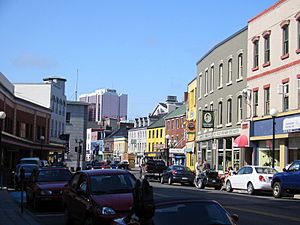
Downtown St. John's is the city's cultural heart and a popular spot for tourists. Water Street and Duckworth Street are famous for their brightly colored historic buildings. These buildings house many tourist shops, clothing stores, and restaurants.
George Street, a side street downtown, is known for its lively nightlife. It hosts yearly festivals, including the George Street Festival in August and the Mardi Gras Festival in October. This street has helped many musicians start their careers.
The city has a symphony orchestra, a string quartet, and several choirs. Memorial University of Newfoundland's School of Music also has many music groups. St. John's also hosts the Tuckamore Festival for chamber music every August. Opera on the Avalon performs operas in the summer. The Kittiwake Dance Theatre, started in 1987, is one of the province's top dance companies.
The LSPU Hall is home to the Resource Centre for the Arts. This "Hall" is a lively place for artists and helps develop the arts downtown. Many famous Newfoundland artists started their careers there, like Rick Mercer and Mary Walsh. The St. John's Arts and Culture Centre has an art gallery, libraries, and a 1000-seat theater. This is the city's main place for entertainment shows.
The Nickel Film Festival and the St. John's International Women's Film Festival are two independent film festivals held every year. Lawnya Vawnya is an annual music festival.
Museums to Explore
The Provincial Museum of Newfoundland and Labrador was once on Duckworth Street. In 2005, the museum, along with the Art Gallery of Newfoundland and Labrador and the Provincial Archives, moved into The Rooms. The Rooms is Newfoundland and Labrador's main cultural building, located downtown.
Other museums include the Railway Coastal Museum. This transportation museum is in the old train station building on Water Street. The Johnson Geo Centre is a geology center on Signal Hill.
Important Historic Sites
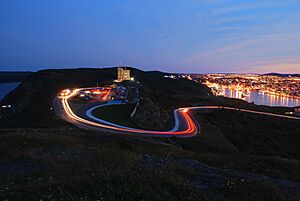
The Murray Premises is a National Historic Site in downtown St. John's. These buildings were once used for fishing, drying fish, and storing goods. The oldest building was built after the 1846 fire. The Murray Premises was updated in 1979. Now it has offices, restaurants, shops, and a hotel.
Signal Hill is another National Historic Site. It is a hill that looks over St. John's. On the hill is Cabot Tower. It was built in 1897 to celebrate 400 years since John Cabot arrived in Newfoundland. It also marked Queen Victoria's Diamond Jubilee. The first wireless message across the Atlantic was received here by Guglielmo Marconi in 1901. Today, Signal Hill is a very popular place for both tourists and locals. Most tourists visit Signal Hill. You can see the Signal Hill Tattoo, which shows soldiers from 1795. The North Head Trail offers amazing views of the Atlantic Ocean.
Parks and Green Spaces
Pippy Park is a large urban park in the east end of the city. It covers over 3,400 acres, making it one of Canada's biggest urban parks. The park has many fun things to do. These include two golf courses, the province's largest campground, and trails for walking and skiing. It also protects homes for many plants and animals. Pippy Park is also home to the Fluvarium. This is an education center that shows a cross-section view of Nagle's Hill Brook.
Bowring Park, in the Waterford Valley, is one of the most beautiful parks in St. John's. You enter the park on Waterford Bridge Road. There's a duck pond and a statue of Peter Pan. The land for the park was given to the city in 1911 by Sir Edgar Rennie Bowring. The park officially opened on July 15, 1914.
Bannerman Park is a Victorian-style park near downtown. It was opened in 1891 by Sir Alexander Bannerman, who was the Governor of Newfoundland. He gave the land to create the park. Today, the park has a public swimming pool, a playground, a baseball field, and large open grassy areas. Bannerman Park hosts many festivals and sports events. These include the Newfoundland and Labrador Folk Festival. The park is also the finish line for the yearly Tely 10 Mile Road Race.
Botanical Garden
Memorial University of Newfoundland also runs the Memorial University of Newfoundland Botanical Garden. It's a great place to see different plants.
Sports and Recreation

Hockey in St. John's
St. John's has been home to several professional hockey teams. The St. John's Maple Leafs played in the American Hockey League (AHL) from 1991 to 2005. They moved to Toronto to be closer to their main team.
After that, the St. John's Fog Devils played in the Quebec Major Junior Hockey League (QMJHL) for three seasons. They left in 2008 due to problems with their arena lease and low attendance.
From 2011 to 2017, the St. John's IceCaps played in the AHL. They were linked to the Winnipeg Jets and later the Montreal Canadiens. Both teams moved to be closer to their main clubs.
In 2018, the ECHL added a new team in St. John's, the Newfoundland Growlers. They became linked with the Toronto Maple Leafs, bringing the Leafs back to St. John's. However, the Growlers stopped playing in April 2024.
Other Sports to Enjoy
The St. John's Edge was a professional basketball team. They played in the National Basketball League of Canada starting in 2017. They used the Mile One Centre as their home. In 2021, the Edge did not get to renew their lease at the arena.
In September 2021, the city signed a deal to bring the American Basketball Association team, the Newfoundland Rogues, to the Mile One Centre. A few weeks later, Mary Brown's, a local fast food chain, bought the naming rights to the arena. It is now called Mary Brown's Centre.
The Atlantic Rock is a men's rugby union team. They play their home games at Swilers Rugby Park. St. John's hosted a Rugby World Cup qualifying match in 2006. Canada beat the United States to qualify for the 2007 World Cup.
St. John's is home to North America's oldest yearly sporting event, the Royal St. John's Regatta. It started in at least 1816. This event is so important that the Regatta day (the first Wednesday in August, if the weather is good) is a public holiday. It's one of the few weather-dependent holidays in the world!
The Tely 10 Mile Road Race is a yearly 10-mile race. It starts in Paradise and finishes at Bannerman Park. Over 2,500 runners take part. It began in 1922, making it one of Canada's oldest road races.
St. John's was where the Canada men's national soccer team first qualified for the FIFA World Cup. This happened on September 14, 1985, when they beat Honduras 2–1 at King George V Park.
Curling has become popular in St. John's. The 2005 Scott Tournament of Hearts, Canada's women's curling championship, was held at Mile One Centre. The 2006 Olympic gold medal men's curling team, led by Brad Gushue, is based in St. John's. Gushue and his team helped bring the Tim Horton's Brier (men's curling championship) to the province in 2017. They went on to win the Brier and the World Championships that year. The city has two curling clubs.
The St. John's Avalon Harps are the local Hurling and Gaelic Football team. They compete in Canadian Gaelic Athletic Association events.
St. John's has also hosted other big sports events:
- 1977 Canada Games
- 1994 Women's Softball World Championship
- 1997 Jr. Men's Softball World Championship
Walking and Hiking Trails
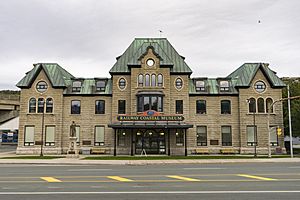
There are many walking paths in the city. The most important is the Grand Concourse. It has trails all over the city, including around Quidi Vidi Lake, parts of Signal Hill, downtown, and along river banks. The Grand Concourse also goes into Mount Pearl.
There are also many kilometers of paths in Signal Hill National Historic Park and the Memorial University of Newfoundland Botanical Garden. The White Hills, behind the Department of Fisheries and Oceans, also have trails for mountain bikers, runners, and walkers.
The Trans Canada Trail starts in St. John's at the Railway Coastal Museum. It follows the old Newfoundland Railway track across the island. It now starts at Cape Spear and connects to the museum. The East Coast Trail also passes through St. John's. It comes from Topsail Beach in the north, goes through Quidi Vidi, Signal Hill, and Water Street, and then connects with the Trans Canada Trail.
City Services and Transport
Getting Around St. John's
St. John's has a large harbour. It is a base for many Canadian Coast Guard (CCG) ships, including several icebreakers.
Airport Travel
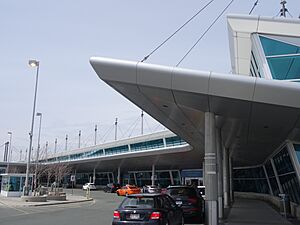
St. John's is served by St. John's International Airport. It is located 10 minutes northwest of downtown. In 2011, about 1.4 million passengers used the airport. This made it the second busiest airport in Atlantic Canada. You can fly to places like Toronto, Halifax, and Montreal. There are also flights to smaller places in the province. International flights go to places like London, Saint-Pierre, and sunny destinations like Cancún.
Driving in the City
St. John's is the eastern end of the Trans-Canada Highway (Route 1). This is one of the longest national highways in the world. The highway, also called "Outer Ring Road", runs just outside the main part of the city. It has exits to other main roads, making it easy to get to different neighborhoods.
Cycling Paths
The St. John's Cycling Master Plan started in July 2009. The first part of the plan includes 43 kilometers of painted bike lanes on roads. It also adds signs on 73 more kilometers of roads. There will be 20 new places to park bikes and bike racks on all 53 city buses.
Public Transit
Metrobus Transit runs the public transportation system in the area. Metrobus has 19 routes and 53 buses. It carries over 3 million riders each year. Buses go to places like the Avalon Mall, Memorial University, and the city's hospitals. They also serve areas like Goulds and Kilbride.
Old Railway Line
St. John's was the eastern end of the Newfoundland Railway. This railway operated from 1898 until it closed in September 1988.
Hospitals and Healthcare
St. John's has several major hospitals. These include the Health Sciences Centre, St. Clare's Mercy Hospital, Waterford Hospital, and the Janeway Children's Health and Rehabilitation Centre. These hospitals are part of NL Health Services, the province's health authority.
Learning and Education
There are 32 English-speaking schools in St. John's. These include primary, elementary, and secondary schools. Two of these are private schools. St. John's also has two schools that are part of the province's French public school district, the Conseil Scolaire Francophone (CSF). The private schools are St. Bonaventure's College and Lakecrest Independent.
The main campus of Memorial University of Newfoundland (MUN) is in St. John's. It is the largest university in Atlantic Canada. MUN offers a wide range of courses and degrees. It was ranked among the top ten comprehensive universities in Canada in 2021. There are also satellite campuses on Signal Hill, St. John's and the Ocean Sciences Centre in nearby Logy Bay. The Fisheries and Marine Institute of Memorial University of Newfoundland (MI) is a post-secondary school focused on ocean and marine studies. It is linked with Memorial University.
The College of the North Atlantic (CNA) is the public college of the province. It has two main campuses in the city. CNA offers programs for careers, trades, and university transfers.
The city also has several private colleges. The largest ones are Academy Canada, Eastern College, and Keyin College.
Local News and Media
The Telegram is the daily newspaper in St. John's. Other local papers include The Muse and The Gazette. Le Gaboteur is a French-language paper. St. John's also receives the national newspaper The Globe and Mail.
CJON-DT, known as "NTV", is an independent TV station. It shows entertainment programs from Global and news from CTV and Global. Rogers Cable has its main office in St. John's. Their community channel, Rogers TV, airs local shows. CBC Television (CBC) has its Newfoundland and Labrador headquarters in the city.
The city has 15 AM and FM radio stations. Two of these are French-language stations. The VO radio prefix was used for Newfoundland before it joined Canada in 1949. Some AM stations still use their old call letters. Other commercial radio stations use prefixes like CF–CK, similar to the rest of Canada.
allNewfoundlandLabrador is the city's daily online newspaper. It focuses on business news from across the province.
Famous People from St. John's
Many interesting people have come from St. John's.
Sister Cities
St. John's has special connections with two other cities around the world:
- Ílhavo, Portugal
- Waterford, Ireland
See also
 In Spanish: San Juan de Terranova para niños
In Spanish: San Juan de Terranova para niños



